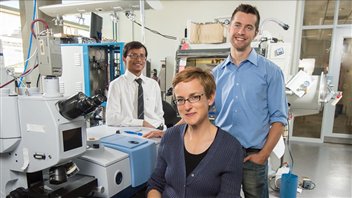Current technology in solar panels are generally fairly heavy and bulky panels. They require sturdy frames and mounts, and are energy intensive to manufacture. Some also use fairly rare elements as well. They are also generally fairly expensive.
Researchers at the University of Alberta have developed an entirely new technology with promise to eliminate virtually all thise concerns.
Jillian Buriak is a chemistry professor, Canada Research Chair in Nanomaterials, and senior research officer of the National Institute for Nanotechnology based on the U of A campus. She leads the team which includes post-doctoral fellows Erik Luber and Hosnay Mobarok.
Listen

Solar panel innovation: cheaper, more versatile, and environmentally friendly
Inspired by an article in a scientific journal Professor Buriak and her team began exploring the potential of readily available and abundant materials, specifically, zinc (dimethyl zinc) and phosphorous (phosphine ligand), to create zinc phosphide.
Through relatively simple and inexpensive processing, the material was reduced to nano particle size which can be held in suspension in a liquid.
Although still in the early stages, the concept holds great promise as a low-cost commercial-scale process as its hoped that the liquid containing the light-converting nano particles can then be applied to surfaces such as in a printing process like a newspaper printing process or spray painting onto any number of surfaces.
Potentially, houses could be painted in the material, thereby turning the entire house into an energy creating source.
It’s also hoped this would be a huge improvement in generating electricity in more remote areas where use of current technology panels is limited due to their bulk, and the costs in purchase and installation.
“With demand for electrical power expected to double by the year 2050, it is important that renewable energy sources like solar power are made more affordable by lowering the costs of manufacturing,” said Dr Buriak.
Although a patent has been applied for, Professor Buriak is quick to point out it may be as long as ten years before the process is developed on a commercial scale and available to consumers.
Creating nano-technology from readily available compounds, itt’s a liquid, like an ink, that may someday result in solar panels being mass printed like newspapers, or sprayed on surfaces like paint. This would result in great saving to the consumer. The research with funding help from NSERC, The Natural Sciences and Engineering Research Council of Canada, has been published in the journal ACS Nano.







For reasons beyond our control, and for an undetermined period of time, our comment section is now closed. However, our social networks remain open to your contributions.